Exclusive: Rescue Tube Program Launches at South Maui Beaches
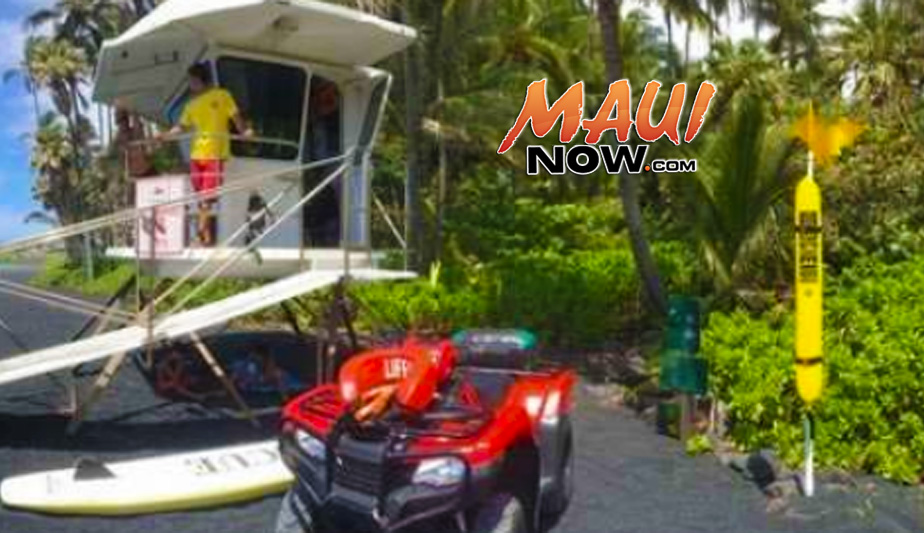
PC: Hawaiʻi Island, credit Rescue Tube Foundation.
A rescue tube initiative that started on the island of Kauaʻi in 2009 is now making its way to Maui as advocates combat alarming statistics surrounding ocean deaths in island waters.
According to the state Department of Health, ocean drownings are the second leading cause of fatal injuries in Maui County.
The numbers are even higher for visitors with 101 out of the 138 ocean drownings reported in Maui County, claiming the lives of visitors between 2006 and 2015.
MaryMargaret Baker, Co-Chair of the Rescue Tube Committee, who is spearheading the project with the Rotary Club Kīhei-Wailea said, “It’s such a magnificent project and it will save lives.”
Citing the statistics above, she said “It really does affect everybody,” and after two-and-a-half years of working through an agreement with the County to get the project implemented, she said it is “finally ready to launch.”
The agreement was initiated by Colin Yamamoto, battalion chief of the Maui Fire Department’s ocean safety division, but maintenance and upkeep will be the responsibility of the Rotary Club.
Baker said, plans are to start installing rescue tubes in two to three weeks at selected sites in South Maui.
According to the agreement, which was signed yesterday, Rescue Tube Stations may be placed at the following beach parks: Kalama Beach Park, Cove Beach Park, Charley Young Beach Park, Kamaʻole Beach Park I, Kamaʻole Beach Park II, Kamaʻole Beach Park III, and Hāna Bay Beach Park.
Plans are to approach the island’s other Rotary Clubs to implement similar agreements in other parts of the island in the future.
How they Work:
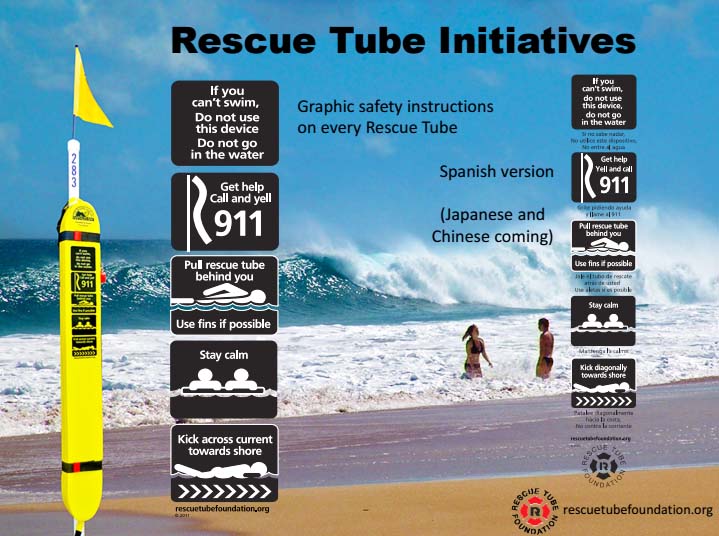
Rescue Tube instructions.
When the rescue tube initiative was launched on Kauaʻi, advocates began educating the public about the personal flotation devices which are available to the public around the clock to stabilize swimmers in distress while they either wait for rescue by lifeguards, or find their way to shore. Advocates say the device is especially useful at unguarded beaches.
The rescue tube is an approximately 50-inch long flotation device intended to be used as a lifesaving device for an individual needing to assist a swimmer in distress. It is intended to keep two individuals afloat until rescue services respond to the scene. The primary objective of this effort is to enhance the safety of beach and ocean-goers at public parks.
Each rescue tube is mounted to an approximately 2-inch diameter PVC pole and is fitted with a yellow flag at its uppermost end to ensure maximum visibility. Graphic safety steps, custom designed by the Rescue Tube Foundation, are provided on each tube with a short list of instructions: (1) If you can not swim, do not use this device. Do not go in the water; (2) Get help. Call and yell 9-1-1; (3) Pull rescue tube behind you. Use fins if possible; (4) Stay calm; and (5) Kick (diagonally) across current towards shore.
In addition, each pole has a three-digit number on it, so that individuals calling 9-1-1 who are unfamiliar with the area, can give dispatchers the number which coincides with the GPS coordinates of each pole. This was implemented to ensure expeditious response to areas that are within cell range.
Baker said the rescue tubes are there to be used when needed for people who are in trouble. She hopes that educating the public about their purpose and use will help to prevent any potential issues with vandalism or theft, which she noted has been minimal on Kauaʻi.
Deployment on Maui:
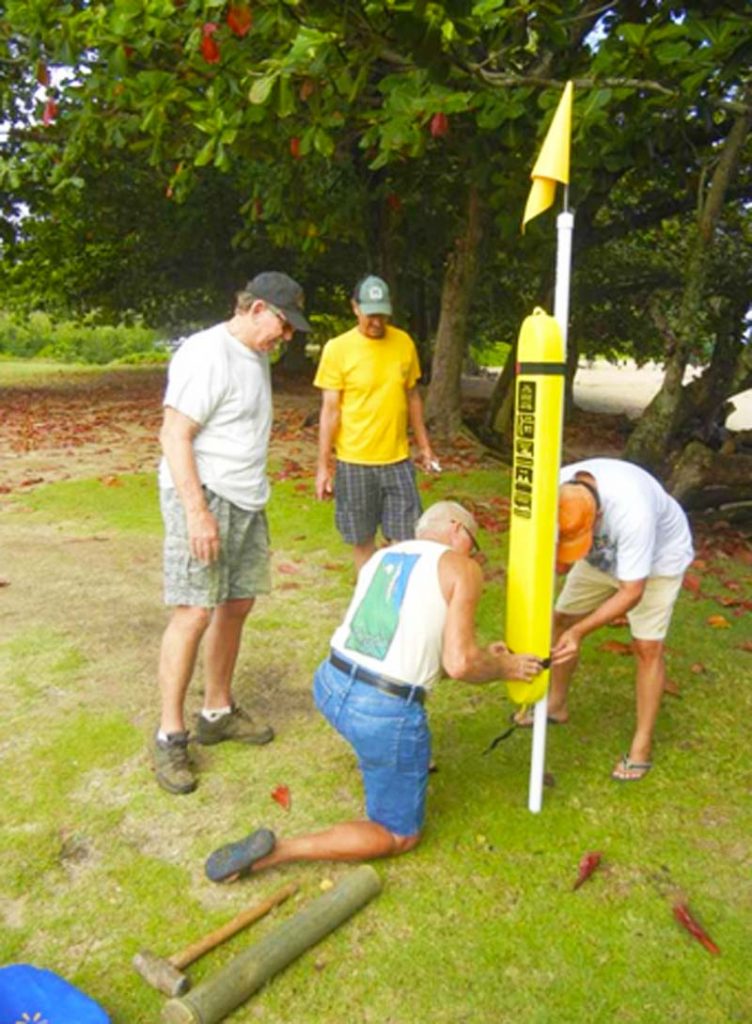
Rescue tube installation. Courtesy image.
The inaugural program on Kauaʻi is funded and maintained through the island’s Kauaʻi Lifeguard Association, with support, both from Kauaʻi Rotary Clubs and the Rescue Tube Foundation. The program has resulted in the installation of 240 tubes on that island.
The rescue tubes were then deployed on Hawaiʻi Island where crews have since completed installation at county parks.
Now, Maui is set to follow suit with dozens of tubes already installed along shores in Kāʻanapali and Lahaina, as well as a small stretch of beach in Wailea.
The initial Maui deployment was made possible through purchases made by the Kāʻanapali Operators Association which installed 27 rescue tubes along properties in Kāʻanapali. The Royal Lahaina Resort also bought four tubes about four years ago and installed them fronting their resort; and the Fairmont Kea Lani bought three tubes in 2015 and reported three saves within just four months of installation. (See Success Stories below).
Much like the Kauaʻi program, the newest installations on Maui involve an agreement between the County of Maui and an island non-profit, the Rotary Club Kīhei-Wailea.
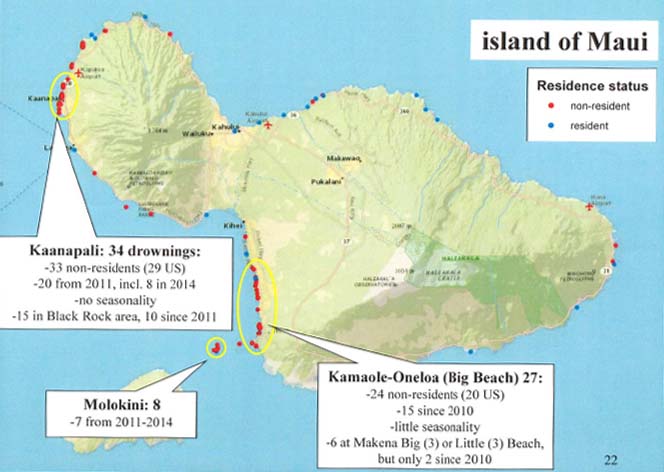
PC: Hawaiʻi Department of Health ocean drowning graphic for Maui.
Currently Rotary Club Kīhei-Wailea has about 25 tubes on hand and the club has made arrangement to purchase another 25. The new tubes will be installed along the south shore of Maui at County beaches from north Kīhei to past Mākena. Installations in Mākena are still however pending approval by the state Parks Department.
The area is of particular interest because of the number of drownings reported in recent years. Over the 10-year period ending in 2014, 31 lives (27%) were lost to drowning on the stretch of shoreline between Kīhei to Mākena, out of the 114 drownings reported in Maui County.
Success Stories:
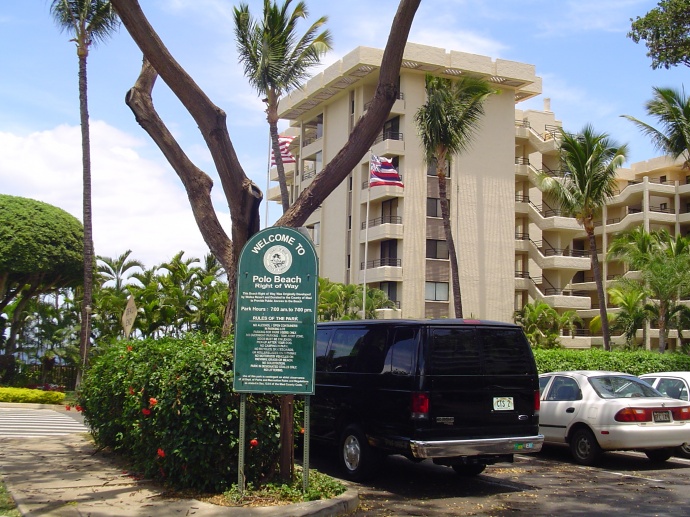
On Thursday, 12/22/11, at 9:55 a.m., a vehicle break-in was reported near Kaukahi Street and Makena Road at the Polo Beach Access Parking Lot. File photo by Wendy Osher.
Program backers have cited 130 successful documented rescues between 2008 and 2016, including: newlyweds who were saved by a Good Samaritan using a rescue tube at Kealia Beach on Kauaʻi on Christmas Eve of 2013; A family of five was also rescued by an off-duty firefighter Jeff Maki who utilized two rescue tubes during the incident at Pololū Valley on Hawaiʻi Island in 2014; and two young boys were saved by their father who used a rescue tube to assist his sons at Hanakāpīʻai Beach on Kauaʻi in April of 2010.
At least three successful rescues were reported offshore of the Fairmont Kea Lani, within just four months of installation including the following documented incidents:
- At around 5 p.m. on Sept. 4, 2015, a 64-year-old man, who was a guest at the hotel, was rescued along with his friend who went to his aid. The guest stated that he was aware of the dangerous ocean conditions, but through he would stay near the shore. A strong undertow current pulled him out into the ocean, and the man suffered from a leg cramp when he attempted to swim against the current. The man yelled for help and his friend swam out to assist, but also experienced difficulty getting back to shore. Two local males with boogie boards and a hotel beach attendant used the rescue tube to safely bring the distressed swimmers back to shore.
- At around 4:30 p.m. on Jan. 10, 2016, a hotel guest was swimming with two other family members. The man’s son-in-law and daughter headed back to shore, while the 67-year-old father decided to swim a little longer. While in the water, a strong undertow current pulled him out into the ocean and he yelled for help. Two bystanders, who were not guests of the property swam out to him using a rescue tube and brought the man safely to shore.
- At around 8:30 a.m. on Feb. 14, 2016, a 15-year-old boy stated that while boogie boarding at Polo Beach fronting the Fairmont Kea Lani, Maui, he was caught in a strong current that pushed him towards the rocks. He tried hard to paddle against the current, but was pushed into the sharp lava rock outcropping. He was so exhausted that he wanted to abandon the boogie board and try to swim to safety, but he was instructed not to do so. A hotel beach attendant retrieved the rescue tube and headed out into the ocean where they were able to successfully rescue the boy, who was a hotel guest, and bring him to shore safely.
There are also locations on Maui where rescues have occurred repeatedly before emergency responders are even called to assist. One location in particular at Honokōwai Point is notorious for its rip current and has be known to catch unsuspecting visitors by surprise, who have been known to grab onto area buoys as they are pulled out to sea.
Maui Fire Department BC Yamamoto tells us of the spot, located between Kāʻanapali Beach Club and Kāʻanapali Shores in West Maui. Last year he nominated resident and longtime surfer, Don McLeish for the annual People Who Made a Difference award issued by the Maui News for his efforts in conducing over a hundred rescues there. While no rescue tubes are installed there, educational warning signs are now in place to warn of the dangers that exist.
Options Weighed:
Program advocates say that not all situations are appropriate for the use of rescue tubes and there have been situations where bystanders chose to wait for first responders to arrive because conditions posed a risk to additional life.
Under the agreement there are conditions and provisions that appear to limit the County’s liability by requiring the Rescue Tube Group to keep a maintenance log and conduct regular inspections. There’s also provisions that allow the County to request removal or relocation of the stations at the Rescue Tube Group’s own cost and expense.
According to a study conducted by the Hawaiʻi Department of Health, the DOH and the Hawaiʻi Drowning and Aquatic Injury Prevention Advisory Committee recommend swimming at a beach with lifeguards as the most effective way to reduce risk of drowning in Hawaiʻi.
Although there are concerns over possible “double drownings” involving public rescue tubes, program leaders say no such incidents have occurred in their eight years of deployment on Kauaʻi; all the while, their use has been documented in more than 100 rescues to date. Program supporters say public rescue tubes “are a promising adjunct to ocean safety, in the absence of trained first responders.”
When the program was introduced on Hawaiʻi Island, a document identifying anticipated impacts noted that one alternative to the placement of these devices at beach parks is to do nothing. A second alternative was to increase the active supervision of all beach parks by hiring more water safety personnel to ensure maximized coverage.
The applicant found that both alternatives were deemed unfeasible. According to the SMA document, “The first alternative does not recognize the potential for human lives being saved via this very cost effective solution. The second alternative requires a considerable investment in additional staff positions, equipment and support that the County is not in a position to establish. Therefore, it was determined that this proposed development is the most responsible avenue to pursue.”
Positive Findings: Study of Kauaʻi’s Program
A recent study of the Kauaʻi Rescue Tube Program by the Hawaiʻi Department of Health concluded that Kauaʻi beach goers generally notice public rescue tubes, correctly interpret their intended use, and report an enhanced feeling of safety in their presence.
According to the study, of the 585 beach goers surveyed on Kauaʻi, 85% of respondents either “strongly” (39%) or “somewhat” (46%) agreed with the statement “seeing a public rescue tube station at the beach makes me feel safer.” A total of 4% reported the presence of public rescue tubes would make them more inclined to take more risks (e.g. swim or surf in bigger waves); 46% responded that they would be less inclined; and 50% reported rescue tubes would have no influence on their risk taking behavior.
Program backers say they hope education about the device will help to save lives as well as minimize theft and vandalism once the devices are installed at more locations across the island.
Island Based Initiative Spreads to Mainland and Overseas:
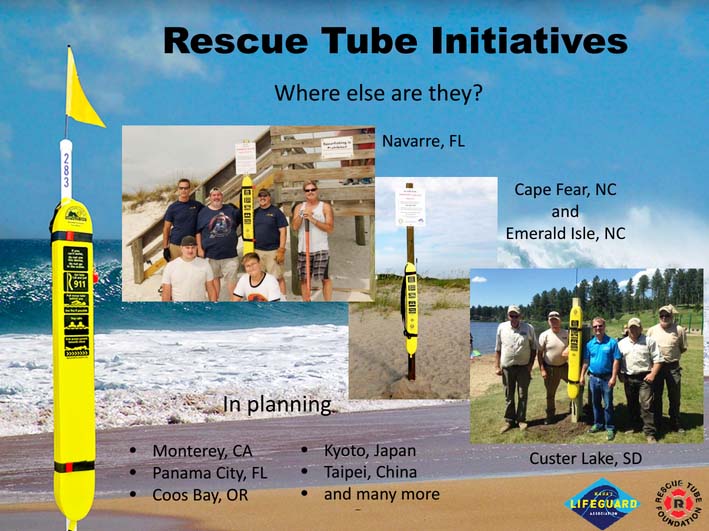
Courtesy image: Rescue Tube Foundation.
Although the rescue tube initiative started on the island of Kauaʻi, there are now more than 20 communities worldwide that use rescue tube stations, or are in the process of planning for implementation.
Branch Lotspeich, Executive Director of the Rescue Tube Foundation, Inc. said the organization aided Maui in the beginning of this process, and continues to promote the completely Hawaiʻi based initiative in a list of other areas around the world.
Outside of Hawaiʻi, communities that have implemented rescue tube initiatives include: Navarre, Fl; Cape Fear, NC; Emerald Isle, NC; Panama City, FL; Custer Lake, SD and many more.
Programs are currently in the planning stages in Monterey, CA, Kyoto Japan, and Taipei, China.










